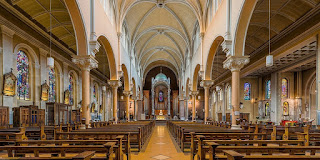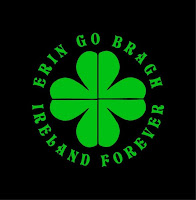 |
| Beautiful County Mayo |
St. Patrick was a slave:
St. Patrick (real name: Maewyn Succat) was born in Britannia about 380 AD to a family of some status. He lived comfortably until age 16, when he was captured by Irish marauders and taken to Ireland. Once there, he was sold to an Irish chieftain who put him to work as a shepherd and that’s what he did for the next six years. I’ve been in Ireland during winter in the comfort of a 21st century life and it was harsh; I can’t imagine what it would have been like to be out in it during the 4th century. Eventually, St. Patrick escaped back to Britannia, where he studied for the priesthood before returning to Ireland in 433 to convert the pagan people that had enslaved him. He is often depicted with a shamrock because he used this common, 3-leafed plant to illustrate the Holy Trinity to the native Irish.
 |
| The interior of Whitefriar Street Church, Dublin |
 |
| Glendalough Round Tower, Coutny Wicklow, Ireland |
experiencing this deep history. Castles abound, as do ruins of all kinds. But, there are some structures that are both extremely old and in extremely good condition – the round towers. There are 65 of these tall (some are over 100 ft. tall) stone structures sprinkled throughout Ireland. They are believed to have been built sometime between the 7th and 10th century. But, no one knows why they were built. Theories abound, of course, including the idea that they are paramagnetic energy receptors. Whatever they are meant to be, they remain as beautiful reminders of past human efforts.

 |
Old school pub: The oldest pub in the world is Sean’s Pub, smack in the middle of Ireland in Athlone, County Roscommon. Still thriving today, it was opened in 900 AD! I’m sorry I missed it while I was in Ireland; it will be on the list for my next visit.
Did an Irishman “discover” America?: Many people believe that St. Brendan (461-577 AD), from County Kerry was the first European to see North America. That’s approximately 500 years before the Vikings and 1,000 years before Columbus!
 The true colors of Ireland: Most people (in America, anyway) think “Green” when they think of Ireland, and it is called the “Emerald Isle” for good reason. But there are other colors that have deep meaning to the Irish. Orange has been a symbol of Protestantism in Ireland since the time of William of Orange (1650-1702). Over the years, green became the color of the Catholics. When the Irish Free State (now known as the Republic of Ireland) gained its independence from England in 1921, they adopted a flag that has green and orange with white in the middle to symbolize the hoped-for peace between the two religions. Like orange, blue is not a color that most Americans associate with Ireland, but it was the original color linked to St. Patrick. In fact, the official “St. Patrick’s Blue” is a lovely sky blue.
The true colors of Ireland: Most people (in America, anyway) think “Green” when they think of Ireland, and it is called the “Emerald Isle” for good reason. But there are other colors that have deep meaning to the Irish. Orange has been a symbol of Protestantism in Ireland since the time of William of Orange (1650-1702). Over the years, green became the color of the Catholics. When the Irish Free State (now known as the Republic of Ireland) gained its independence from England in 1921, they adopted a flag that has green and orange with white in the middle to symbolize the hoped-for peace between the two religions. Like orange, blue is not a color that most Americans associate with Ireland, but it was the original color linked to St. Patrick. In fact, the official “St. Patrick’s Blue” is a lovely sky blue.Surprising Irish heritage: Many millions of Americans can claim some Irish heritage (thanks to the estimated 4.5 million people who immigrated between 1820-1930). Some notable examples: Muhammad Ali, whose great-grandfather left County Clare in the 1860’s and married a free African-American woman in Kentucky, and Barak Obama, whose ancestor fled the famine in
Moneygall, County Offaly in the 1850’s.
 Guinness: This one thing that is as beloved in Ireland as it is in America. Back on December 31, 1759, Albert Guinness signed a lease that may be the longest running ever. He agreed to pay 45 Irish pounds a year for 9,000 years! It’s a good thing that it’s well-loved lager! In case you were wondering, here is a video on how to properly drink a pint.
Guinness: This one thing that is as beloved in Ireland as it is in America. Back on December 31, 1759, Albert Guinness signed a lease that may be the longest running ever. He agreed to pay 45 Irish pounds a year for 9,000 years! It’s a good thing that it’s well-loved lager! In case you were wondering, here is a video on how to properly drink a pint. I hope that all of this adds to your understanding and enjoyment of St. Patrick’s Day. We Irish-Americans have come a long way since my grandmother’s time, when the Irish were often treated despicably. We owe it to our ancestors to honor the homeland and it’s traditions on this grand day.
I hope that all of this adds to your understanding and enjoyment of St. Patrick’s Day. We Irish-Americans have come a long way since my grandmother’s time, when the Irish were often treated despicably. We owe it to our ancestors to honor the homeland and it’s traditions on this grand day.Submitted by Pam






No comments:
Post a Comment